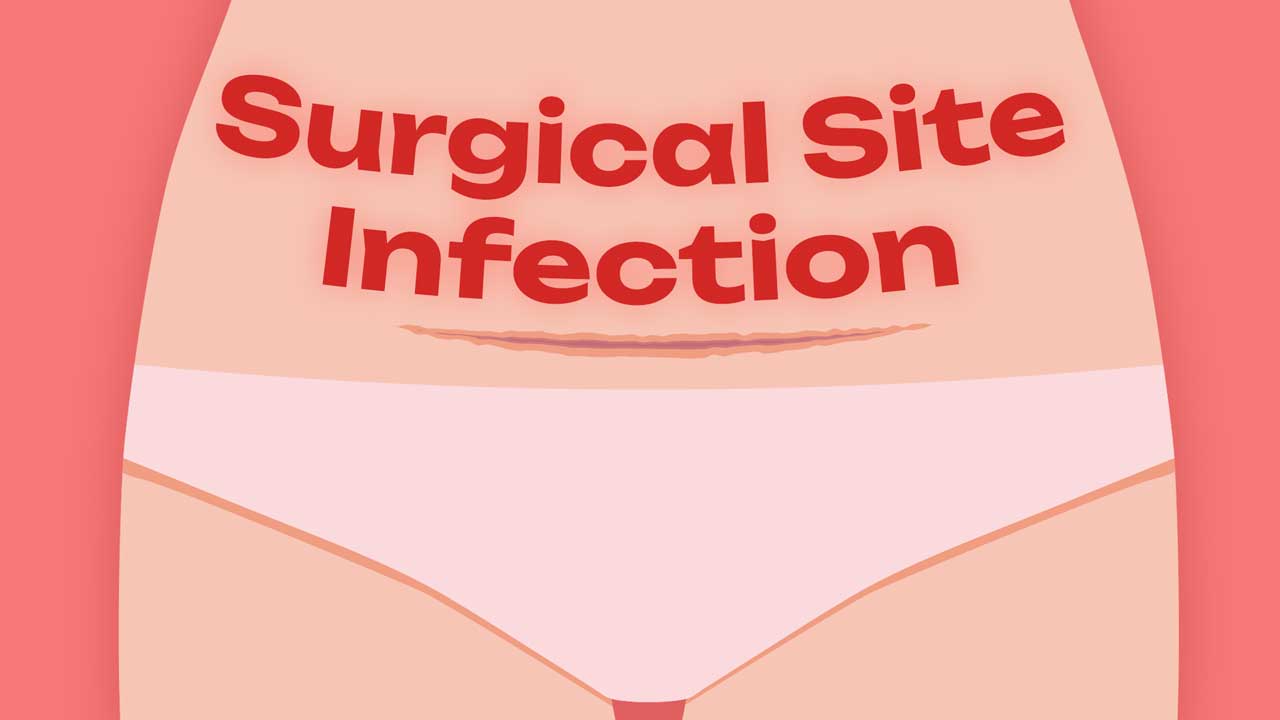Surgical site infection (SSI) is estimated to occur after 5 to 9% of caesarean births (Martin et al. 2021).
SSI typically presents between four and seven days post-delivery with erythema, discharge, warmth and pain at the incision site (Boushra & Rahman 2023).
The most common pathogen responsible for SSI after caesarean birth is Staphylococcus aureus. Other causative pathogens include but are not limited to Staphylococcus lugdunensis, Escherichia coli, coagulase-negative staphylococci and Enterococcus spp. (VICNISS 2022). When wound infection develops within the first 48 hours, the causative microorganisms are usually group A or B streptococcus (Boushra & Rahman 2023).
Not only does SSI cause distress for the patient and prolong postnatal recovery, but it can also cause significant additional strains on staff time and hospital resources.
Risk Factors for Surgical Site Infections
The major risk factors for SSI include both maternal and operative factors.
Maternal factors include:
- Smoking
- Limited prenatal care
- Obesity
- Use of corticosteroids
- Nulliparity
- Multiple pregnancy
- Diabetes
- Premature rupture of the membranes
- Prolonged labour
- Chorioamnionitis.
Surgical factors include:
- Large incision length
- Subcutaneous tissue thickness > 3 cm
- Subcutaneous haematoma
- Lack of antibiotic prophylaxis
- Emergency delivery
- Excessive blood loss at delivery.
(Zabaglo et al. 2024; Berghella 2024; Kawakita & Landy 2017)
Preventing Infection
Using a safety checklist can provide a more structured approach to ensuring, for example, that antibiotics are offered pre-operatively (Combs et al. 2021).
Other effective interventions to decrease the risk of surgical site infection include:
- Prophylactic antibiotic use
- Chlorhexidine skin preparation instead of iodine
- Hair removal using clippers instead of razors
- Placental removal by traction of the umbilical cord instead of manual removal
- Suture closure of subcutaneous tissue if the wound thickness is > 2 cm, and skin closure with sutures instead of staples.
(Kawakita & Landy 2017)
The National Institute for Health and Care Excellence (2024) suggests that no particular type of wound dressing is better than another at reducing the risk of SSI. Negative-pressure wound therapy should also be considered for women with a BMI of 35 kg/m² or higher to reduce the risk of infection. General guidelines to prevent infection include:
- Removing standard dressings 6 to 24 hours after the caesarean birth
- Monitoring for fever
- Assessing the wound for signs of infection (e.g. increasing pain, redness or discharge), separation, or dehiscence
- Encouraging patients to wear loose, comfortable clothes and cotton underwear
- Gently cleansing and drying the wound daily
- Planning the removal of sutures or clips, if required.
(NICE 2024)
Wound Care Advice Post-discharge
It can take 6 to 10 weeks for the wound to heal completely (raisingchildren.net.au 2024).
Self-care advice for patients includes:
- Keeping the wound clean and dry
- Showering or bathing daily
- Washing the wound with water only, drying around the area with a towel, and leaving it uncovered to air dry
- Avoiding the use of creams or powders in the wound area
- Wearing loose, comfortable clothes
- Washing hands with soap and water before touching the wound.
(raisingchildren.net.au 2024; Westmead Hospital 2016; Women’s and Children’s Hospital 2024)
If any of the following symptoms occur, patients should also know who to contact for treatment and advice:
- Fever > 38°C
- Increased pain or swelling of the wound, with redness spreading to the skin around the incision
- Offensive-smelling discharge leaking from the wound site
- Wound appearing to be opening.
(raisingchildren.net.au 2024; Women’s and Children’s Hospital 2024)
The Cost of Complications
Villers (2020) proposes that approximately 10% of patients with a caesarean birth wound experience a complication, most commonly an infection that can cause significant disruption to their life during the postpartum period.
Villers (2020) also suggests that 39% of postpartum hospital readmissions are due to SSI. However, they also note that this number could be even higher in reality, as most studies do not capture the number of patients diagnosed with SSI who are treated as an outpatient. This makes the true cost of complications hard to assess, and to date, there is no reliable published data on the true impact that wound complications have on maternal postpartum recovery.
Wound Care Training for Midwives
As Douville et al. (2020) suggest, knowing how to prevent infection can be just as important as treating an infection once it has already occurred. Yet, there are still considerable international variations in terms of the recommended protocols. Advances in wound dressings and surgical techniques to prevent infection are an ongoing area of research and are yet another aspect of midwifery care that is continually evolving in line with recent medical discoveries.



 New
New 
